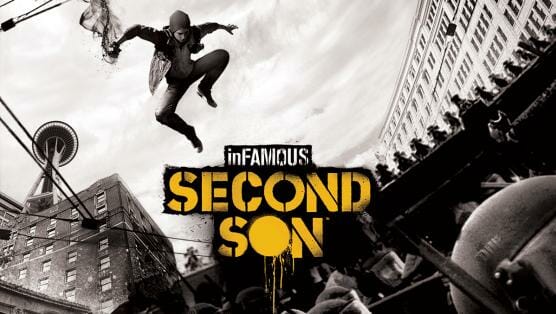Infamous: Second Son (Playstation 4)

Delsin Rowe is a nobody. Catch him graffiti-bombing old billboards in his microscopic hometown. 24 and jobless, a punk without a scene, buoyed only by his anger and his exasperated older brother. There’s no one you’d trust less with a sudden surge of responsibility, much less super powers. So there’s something distinctly Peter Parker-ian when he suddenly finds himself able to smoke-dash through vents and fling fiery chains. Why him? Because he’s foolish enough to embrace the burden? Because he’s relatable in his aimlessness? Because Cole, from the earlier Infamous games, was far too boring? All are valid answers, and all add up to the same conclusion — Second Son isn’t about any huge inter-connected conspiracies. While those mysteries certainly still persist, this is a game about a man and his family, a man and his place in the world, a man and his struggle to transcend the lumberjack flannel under his patched-up vest. Delsin made me angry, but he also made me laugh, and that’s the point.
Structurally Second Son is similar to the previous Infamous games. A personal tragedy draws you and your brother to Seattle for vengeance, and also to acquire a very specific power that can help save the people of your hometown. It’s a large, beautiful open world, decked out in trademark local signifiers (I saw a neon Sub Pop sign.) Delsin is something of a superpower sponge — by merely grabbing the hand of a fellow conduit (essentially the game’s term for X-Men,) he’ll black out for a few moments and gain whatever specific power they might’ve been carrying. These are unlocked over the course of the story, and add up to a pretty diverse arsenal of pain. Without giving too much away, you’ll quickly find yourself running at light speed and wielding the rupturing power of video torrents.
In this sense Sucker Punch have iterated on the Infamous franchise in the most obvious way possible. They’ve given you a bigger open world and more toys to play with. It’s an environment built for combat and mobility — immersion comes second. The streets are fairly uncluttered with people or cars, and you’ll be unable to walk into any buildings. The side-quests are repetitive, simple and fairly inconsequential. Free a district of the city from the D.U.P. (the occupying military police) and it will be unlocked for fast travelling purposes. The way you do that is through blowing up security cameras, destroying surveillance trucks, and tracking down secret agents. These are all generic, and strewn through the world in a failed effort to make it look lived in. In fact the only side-quests that have any meaningful story hook come from tracking down audio logs. If you’re familiar with the previous Infamous games this shouldn’t come as a surprise. Those earlier games were always a little too big for their britches, and the meaninglessness of Second Son’s openness feels disappointingly last-gen.
But still, the narrative remains very strong. Sucker Punch nails Delsin’s devil-may-care charms, as well as his precarious balance of self-importance and duty. His brother Reggie is a lawful-good cop that serves as Delsin’s foil, as well as his closest partner. The other conduits you meet are all messed-up young adults in their own right. There’s something delightfully cyberpunk-y about a group of wayward kids with happenstance abilities working together to take down the authority. Perhaps best of all is your antagonist, Augustine, a woman of absolutely no remorse who makes it quite clear from the beginning of the game that she doesn’t care about anyone’s petty morality. She has that infuriating essence of a villain where you always feel like you’re falling into her trap, no matter what you do.
Weirdly enough, I think the thing I’ll remember most about Infamous: Second Son is the particle effects. Your powers are all super distinct, from the way your body dissolves into smoke or gets plated with concrete. The most memorable imagery comes when you unlock the ability to tap into video signals. Your moves will throw scan lines all over your screen, and the default pea-shooter coats your enemies in glitches and screen-tears. It has the delirious effect of digital disturbance intersecting with the game’s version of real life. Commentary on 21st century society? Maybe, but mostly it just looks cool.
